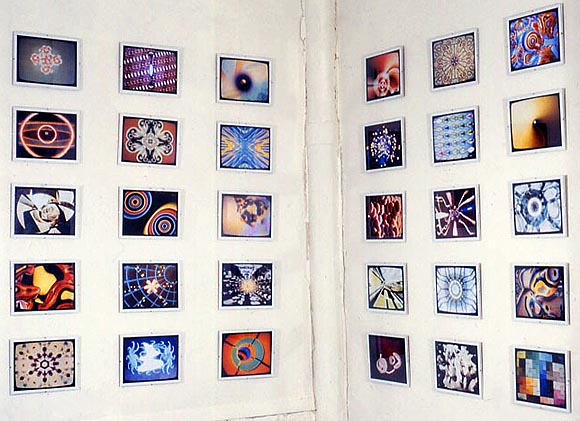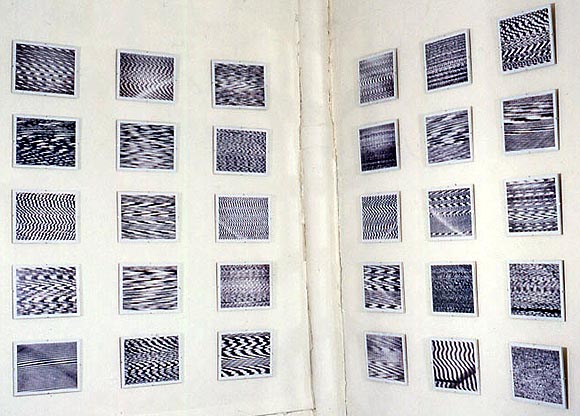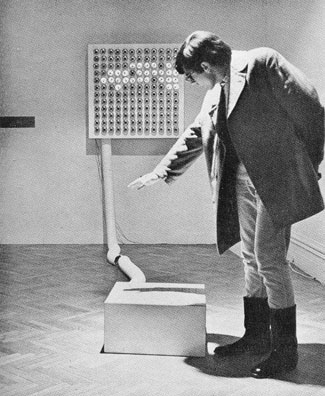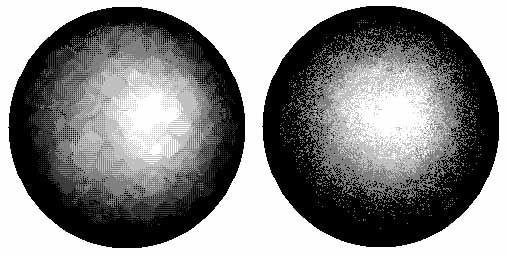View current page
...more recent posts
Some impressions of Christo World in Central Park. Walking briskly under the nylon-draped "gates" gives you the feeling you are under a low canopy or awning. The indoor experience of walking through tunnels and hallways morphs strangely with the outdoor experience of walking through open greenery (or brownery, since it's winter now). This is actually not a good thing. Because of the gates' slick fabrication, you feel as if the park had been rented to demonstrate some newfangled, all terrain, corporate convention habitrail system (shades of George Bush's request for a special platform so his feet would never have to touch the dirt of another New York park--Eisenhower, in Nassau County). This might work if the Christos had any sense of irony or self-awareness, but from their interviews they, or at least J-C, the mouthpiece, are tres earnest that it's all about "feeling." Also, the concept of an artificial second layer hovering over the park's rustic walkways fails due to compromises with the Park board. You're walking through an orange tunnel and it suddenly sputters out to accommodate a series of trees that couldn't be trimmed, or abruptly dumps you into one of Olmsted's large open, rock strewn spaces where a bunch of loose gates stand around without any sense of rhythm, solidity, or purpose. The Christos weren't allowed to dig post holes for the gates, and the concrete "feet" that anchor them are an awkward solution. One has to laugh (good naturedly, of course) at the discretely-inserted shims propping them up to adjust for a path's natural slope. But at the end of the day, bad and corporate-looking as the project is, ya gotta say, "damn, they did a lot of work!"
Below is a sculpture by Ross Knight, the "Un-Christo," at the Sculpture Center last year. Knight was allowed to dig into the earth, paradoxically making his work both more ephemeral and more integrated with its surroundings (see link for how all this worked), and his project succeeds, at least in part, because he accepts the modest scale and doesn't succumb to any urges to sit heavily and selfishly on his fellow humans. He also has a sense of humor.
More discussion of the evil Christo and Jeanne-Claude on this ridiculously long (but not ridiculous) thread on Sally McKay's page. Surprisingly many people have stepped forward both here and there to defend the Christos! (This post has been edited slightly.)

rave video stills - details / more details

tv static photos (w/ Ray Rapp) - details / more details
One way the Christos' latest work might be successful: If each of those proscenium/gate things placed at regular intervals along Central Park walkways served as an obstacle to movement rather than something you walk through. In other words, if instead of flapping aesthetically over parkgoers' heads, the nylon curtains hanging from the gates were lowered completely, anchored to the ground, forcing people to walk around them or physically rip through them to traverse the park. Thus you would have the pure, condensed hostility of Richard Serra's Tilted Arc, which hampered movement across a public plaza, but with the irony of a bright "joyous" color and billowy nylon fabric. People would be angry, the park would be in turmoil until the piece could be removed, and everyone would be talking about it for years, instead of the Christos getting a mere two weeks of ego-gratification and the big Michael Kimmelman thumbs-up.
UPDATE: The nylon "Gates" swatches selling on eBay originally had some "authorized by the Christos" language that has since been removed, so I took out a parenthetical about the couple selling their wares online. Should have known that was too good to be true. In the comments to this post we're discussing what they're actually going to do with all that fabric.
UPDATE 2: This is one of those rare instances where the kneejerk philistinism of the New York Post converges with the highfalutin' critical opinion (mine--but I'm sure there are others) that the Christos are phony or dumbed down conceptualists. They are really the ultimate middlebrow art. From Andrea Peyser's column:
The artists seemed cute and quirky enough. And the mayor was positively giddy about it. That should have been the kiss of doom.UPDATE 3: Hate to keep harping on those fools in the park, but the Christos' arguable past contribution to the history of art is the extension of conceptual (specifically earthwork) practice to include negotiation and logistics, and navigating local bureaucracies and landowners as art. The running fence itself wasn't very interesting--it was the point of what the artist had to do vis a vis obstinate property rights to make art happen that was a new concept 30 years ago. But to go from all the work Christo did to get the fence built to "convincing Mayor Bloomberg" is just a serious fall from grace.
Now I realize we all were pulled into a kind of mass hysteria orchestrated by a couple of charismatic snake-oil salesmen--also known as the artists Christo and Jeanne-Claude--and their pretentious booster, Mayor Bloomberg.
"The Gates" is an abomination. Call me a Philistine, but how can one improve on trees, lakes and rocky outcroppings with miles of plastic-treated cloth?
It's enough of a sin that "The Gates" overpowers Central Park's soaring, hypnotic beauty. But the color of these bed sheets, plunked down on metal frames every 12 feet throughout the park, is so atrocious that the project's creators ought to be charged with assault.
Christo and Jeanne-Claude claim that the hue of the weirdly pleated cloth is "saffron." But, as any American junior-high-school kid will tell you, the precise shade is "vomit orange."
"I can't get over how much it looks like an advertisement for Home Depot," said a laughing auxiliary cop I ran into.
And he said he actually liked them.
"Jeanne-Claude, your design is good, but it needs color to have impact."
"We've done pink."
"And an incredible pink it was."
"I know........."
"What are you thinking, Christo?"
"It's daring."
"Try me."
"You'll laugh."
"I never laugh at your ideas."
"I'm thinking.....Orange!"
"Orange."
"Yes. Orange."
"My God. But wait...didn't we do orange?"
"Mon cheri, you're right. How could I forget Valley Curtain [Rifle, Colorado 1970-72]? All right, no matter, this time instead of orange we'll call it 'saffron.'"
Updated based on some assiduous Christo scholarship from Dan.

Juan Downey and Fred Pitts, Against Shadows, 1968, plywood, Formica, and electronic parts (photo by Shunk-Kender from Frank J. Malina's Kinetic Art: Theory and Practice, 1974). It's as simple as it looks: a grid of photocells on the formica cube responds to shadows and mimics them in reverse on the wall screen. The klutziness of it (e.g., that huge conduit) is, I believe, intentional. Downey's conceptualist-style statement for the work is still refreshing:
"If the choice were given to me, I would pick complete inaction for my entire life. Nevertheless, I persist in the activity of building electronic sculptures because:
Their existence or destruction is irrelevant to the life of them.Such a contrast with the Whitney's "BitStreams" show, where all the art had to have a purpose, and/or the curator killed it with pedantic overexplanation.
They cause people to play.
They make people aware of the vast number of different kinds of energy in the universe.
They are ephemeral. This is part of a new development in the history of art: to create works that are not supposed to last for a long time.
They pose a problem for the collectors of art objects.
They create the illusion that the public can participate in the work of art. Actually we are still spectators mystified by the order that makes the world grow and move, although, we pretend we are determining what happens to us.
It is fun to talk with friends about them.
They imitate aspects of movement in life. Art is more concerned with thinking about what people experience than with producing objects.
They make people aware of lively relations between different kinds of things.
Children like them.
Sometimes they produce a reversal of natural phenomena, for example, as demonstrated by the sculpture Against Shadows."

MSPaintbrush vs. MSPaint: A Refresher
Some kid out there on the internet mentioned my artwork and told his readers that I "apparently use MSPaint." In context, the "apparently" reads like a slightly disdainful qualifier, as in, "I can't see it myself, and in any case I don't think it's a particularly great use of MSPaint, but that's what the guy says--I'm just telling you." Of course I don't share the ambivalent feelings but do think it's time to trot out an earlier post where I explained the difference between MSPaintbrush (which rules) and MSPaint (which I use occasionally even though it's inferior).
Regarding the orange things going up in Central Park: The collective vanity of "Christo and Jeanne-Claude" is bottomless. Perhaps their only value as artists is exposing and exploiting weaknesses in "the system" that allows projects such as theirs to happen. It would be nice to think they were ironic, and knew the physical art was just fodder for a Hans Haacke-like provocation. No such luck, though.
